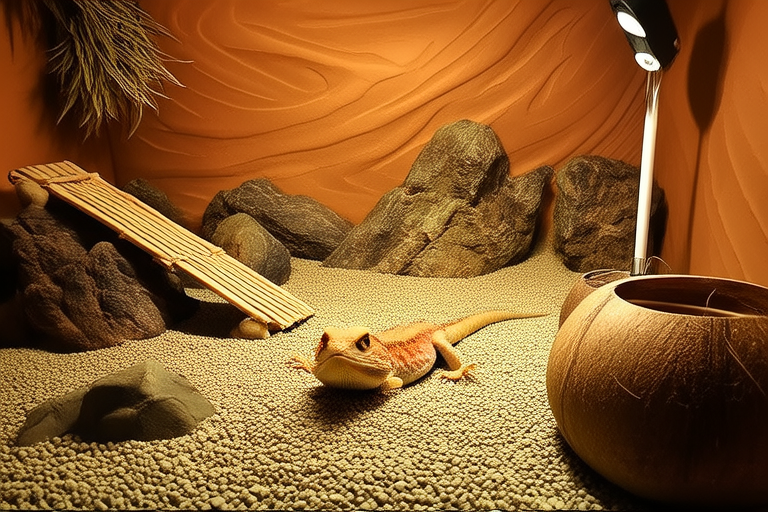DIY Guide: Setting Up a Bearded Dragon Habitat
Welcome to your comprehensive, beginner-friendly guide on setting up a bearded dragon habitat. This guide will walk you through every step of creating a healthy, comfortable environment for your pet. We’ll cover essential components such as lighting, heating, substrate, and enclosure size, providing step-by-step instructions, safety tips, and maintenance advice.
Choosing the Right Enclosure Size
The first step in setting up your bearded dragon’s home is choosing the right enclosure size. Bearded dragons need plenty of space to move around, bask, and explore. The minimum recommended size for a single adult bearded dragon is a 4x2x2-foot (120x60x60 cm) enclosure. If you plan to house multiple bearded dragons, ensure that each one has enough space to thrive.

For juveniles, a smaller enclosure can suffice, but it should still provide ample room for climbing and basking. As your bearded dragon grows, consider upgrading to a larger enclosure to accommodate its needs.
Selecting the Proper Substrate
Substrate is the material that lines the bottom of the enclosure. It should be safe, easy to clean, and provide a natural environment for your bearded dragon. Some popular options include:
- Cypress mulch: Retains moisture well and mimics a natural environment.
- Eco-earth: A mix of coconut fiber and other natural materials.
- Paper towels: Ideal for young bearded dragons or during cleaning.
Avoid substrates like sand, gravel, and wood shavings, as they can cause impaction if ingested. For younger bearded dragons, paper towels are the safest option until they’re old enough to handle more complex substrates.
Setting Up Lighting and Heating
Proper lighting and heating are crucial for your bearded dragon’s health. They need specific temperatures and UVB light to thrive. Here’s how to set up these essential components:
UVB Lighting
UVB light helps bearded dragons produce vitamin D3, which is necessary for calcium absorption. Without adequate UVB exposure, your bearded dragon may develop metabolic bone disease (MBD). Place a high-quality UVB bulb on one side of the enclosure, ensuring it covers at least half of the tank. Replace the bulb every six months or according to the manufacturer’s recommendations.

Basking Spot
Your bearded dragon needs a warm spot to bask under a heat lamp. Install a ceramic heat emitter or basking bulb on the opposite side of the enclosure from the UVB light. The basking spot should reach 95-110°F (35-43°C). Use a thermometer to monitor the temperature accurately.
Temperature Gradient
Create a temperature gradient by placing the heat source at one end of the enclosure. This allows your bearded dragon to regulate its body temperature by moving between warmer and cooler areas. Maintain a cool side temperature of 75-85°F (24-29°C).
Providing Hides and Climbing Structures
Bearded dragons enjoy hiding and climbing, so it’s essential to provide appropriate accessories within their enclosure. These items also help stimulate mental and physical activity.
- Hides: Offer two hides – one on the warm side and one on the cool side. This allows your bearded dragon to retreat when needed.
- Climbing structures: Branches, rocks, and other objects provide opportunities for climbing and basking.

Feeding Your Bearded Dragon
Proper nutrition is vital for your bearded dragon’s health. Offer a balanced diet consisting of insects, vegetables, and occasional fruits. Dust insects with calcium powder and multivitamins before feeding them to your dragon.
- Insects: Crickets, dubia roaches, and mealworms are excellent protein sources.
- Vegetables: Dark leafy greens, carrots, squash, and bell peppers are nutritious choices.
- Fruits: Offer fruits sparingly, as they contain high amounts of sugar.
Provide fresh water daily in a shallow dish that your bearded dragon can easily access.
Maintenance and Cleaning
Regular maintenance ensures a clean, healthy environment for your bearded dragon. Clean the enclosure weekly, removing waste and replacing soiled substrate. Deep clean the enclosure monthly, disinfecting all surfaces and equipment.
- Spot cleaning: Remove waste and replace soiled substrate as needed.
- Deep cleaning: Disinfect all surfaces and equipment monthly.
- Lighting and heating: Check bulbs regularly and replace them as needed.
Safety Tips
Creating a safe environment for your bearded dragon is paramount. Follow these safety tips:
- Avoid using any toxic materials or chemicals in the enclosure.
- Ensure all equipment is securely mounted and out of reach of your bearded dragon.
- Monitor the temperature and humidity levels regularly.
- Keep the enclosure away from drafts and direct sunlight.
Maintaining a Healthy Environment
By following this guide, you’ll create a healthy, comfortable environment for your bearded dragon. Regular monitoring, proper care, and attention to detail will ensure your pet thrives. Remember to consult with a veterinarian or experienced reptile keeper if you have any questions or concerns.
With dedication and effort, you can provide your bearded dragon with a wonderful home that promotes happiness and longevity. Enjoy the rewarding experience of caring for this fascinating reptile!
